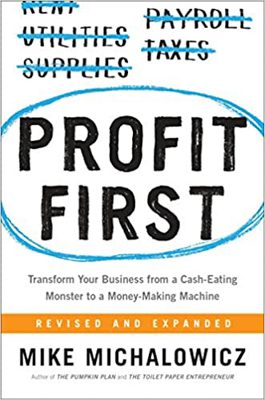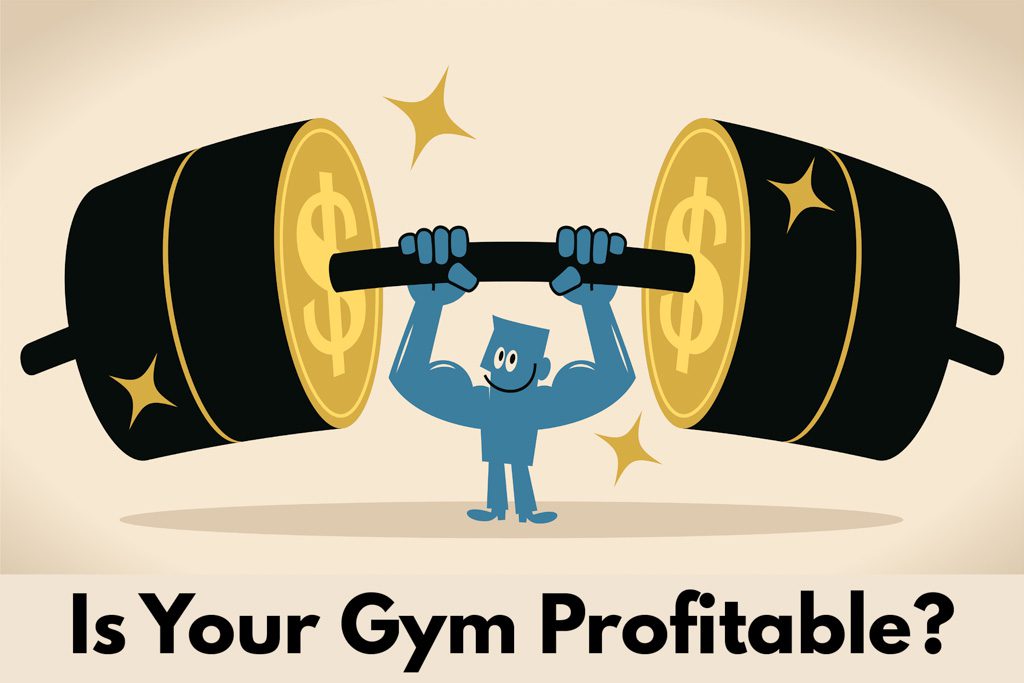If you mention a Profit First gym accounting strategy to many fitness entrepreneurs, you might get the question, “What profit?”
Because many gym owners run hand-to-mouth operations, it’s hard for them to even think of implementing a Profit First gym bookkeeping strategy when they aren’t generating a gym profit.
The solution is simple: Gym owners should “create” profit immediately by setting aside a portion of monthly gym revenue before addressing anything else.
This revolutionary gym accounting strategy is simple, but making it work for your fitness business takes diligence and innovative thinking. When properly implemented, the Profit First approach can completely change the way you think about gym bookkeeping and ensure your business becomes strong and stable.
Below, you’ll learn:
- How Profit First is defined.
- Why you need to optimize your gym accounting for success.
- What Profit First can deliver.
- How Profit First works—i.e., “where the money comes from.”
- How to maximize the benefits of Profit First at your gym.
- Using checks and controls in your first year of Profit First.
What Is Profit First?
Profit is the most important element in running a gym business. However, gym owners often put it last.
Many gym owners get into the business to help people, and their “business” is actually a labor of love that’s more of a self-created job than a true enterprise. The roadmap is typically to work very long hours, break even at some point and maybe hit profitability—or not. Because profit isn’t a priority, small surpluses are often eaten by equipment purchases, renovations and other expenses.
In the worst cases, the gym has no profit at all, and many owners don’t even take a reasonable salary. Instead, they focus solely on supporting their clients and their team. This approach might seem noble, but it’s not a sound way to run a gym. Inevitably, these dedicated gym owners burn out and quit or have to leave the business to find other ways to support their families.
In fact, stats show less than half of new gyms will make it to the five-year mark.

If you’ve owned your business for a while, you’ll understand why half the gyms in the industry fail within five years. You operate in a highly competitive environment. Most of your time is not your own, and you solve the bulk of the problems in the business. You wear every hat, from cleaner to CEO, and it’s very hard to find, develop and retain staff. You are the heart and soul of your gym, and everyone looks to you for motivation and leadership, but you’re tired and underpaid. Without proper compensation, you will eventually burn out and your business will suffer.
Profit First gym accounting is designed to solve these problems. By taking a slice of the revenue for profit first, you will ensure that you’ll get paid.
The traditional approach is that profit is what’s left over.
Sales – expenses = profit
But in the microgym industry, you seldom have left-overs. So the owner goes without.
Here’s the basic principle of Profit First, as laid out by accountant John Briggs in the book “Profit First for Microgyms”:
Sales – profit = expenses

This alteration to the formula represents a dramatic and powerful mindset shift for a gym owner. By automatically placing your profit in the no-touch zone, Profit First eliminates the temptation to look at the balance in your business bank account and assume you have the entire amount to work with.
The biggest difference between the traditional and Profit First approaches is that the traditional gym accounting mindset doesn’t require you to install money management systems. Profit First demands strict money management (see below).
For the original, general Profit First plan, read “Profit First” by Mike Michalowicz.
What Does Profit First Accomplish?
Prioritizing gym profit puts you, the owner, first. That’s essential because if you aren’t there, the business disappears, too—at least until you hire staff to run it.
With a portion of revenue marked “sacred” and allocated to you, you have less money to operate your gym (unless you generate more revenue—which is a good thing). But by allocating profit first, you’ll be forced to examine your business model, your operational procedures and all the elements that cause profit erosion in your gym businesses. Here’s a big one: Parkinson’s law.
The formal definition of Parkinson’s law: “Work expands to fill the time available for its completion.”
Applied to a gym business, Parkinson’s law suggests spending will always increase to the level of the money supply.
Spending Whatever Is There
Here’s a simple example: The parents of a first-year college student want to make their son financially comfortable while he’s in school so they give him a credit card with a $2,000 limit. Each month, the parents pay off the balance in full, but they notice that the card’s available balance is zero by the end of each month. So they raise the card’s limit to $3,000. But the card is still always maxed at the end of the month.
When the parents ask their son about his increased spending, he shrugs and says that he just spends whatever funds are available each month.
The same thing happens in businesses that don’t set aside profit. Profit becomes an afterthought, and the gym owner starts spending money on coffee bars, staff raises, new equipment and so on. You can always find something to spend money on—and you will. With profit set aside, you ensure that you’re taken care of first.
No matter what you spend later, the gym owner still gets to eat. Suddenly some expenses don’t seem essential. Questions like this are common with Profit First gym bookkeeping in place.
“Do I really need four new airbikes?”
“Will a new couch in the lobby generate ROI?”
“Am I using all these subscriptions? Are some redundant?”
The Profit First gym accounting approach fundamentally changes your businesss. By immediately taking out the profit share from your monthly revenue, you limit the money available to run your business. It’s like putting your business on a diet.

The Impact of Profit First
When you purposely impose restraint on your business spending, it prompts you to put a laser focus on your business operations and accounting practices. As a result, your gym business will operate more efficiently while you work to improve your financial circumstances. You must dig in and eliminate all wasteful spending and evaluate your available resources to maximize their potential. A dollar spent should actually be a dollar invested.
By creating a limited operations budget, the Profit First approach helps you abandon the old habit of throwing money at problems. In some cases—but not all—you should invest your way out of a problem. The word “invest”—not “spend” is key.
Here’s a simple and low-cost example: You can spend hours trying to solve common gym problems. Or you can spend $8 on Chris Cooper’s book “Gym Owners Handbook.” If the book saves you even a single hour of time, your ROI is on that $8 is already huge.
Apply the same principle to other spending and ask this question: “Am I getting a return on this investment?”
Here’s another way to state that question from a Profit First perspective: “Will this expense allow to me generate more revenue and profit?”
Don’t underestimate the effects of owning a profitable business. They’re immense, and they can be tangible and intangible. Profit will ensure you can feed your family, take a vacation or buy that thing. But it will also boost your morale because you know your work is being rewarded. Slaving away in silence as a martyr gets old very quickly.
The Active Managerial Accounting Behind Profit First
You can put Profit First in motion by setting up multiple accounts at your bank. Here’s the structure of accounts Briggs outlines in “Profit First for Microgyms.”
- Income.
- Profit.
- Owner’s Pay.
- Team Members.
- Tax.
- Equipment.
- Operations.
These accounts serve as the partitions for your gym budget.
Income goes into the Income account and is then moved to the other accounts according to your exact financial strategy. You don’t spend money in the income account.
Let’s explore the others:
Profit Account
For most entrepreneurs, their business is their ultimate investment. And as with any investment, the goal is to see a return on investment (ROI). Profit is the owner’s or owners’ reward for owning the business. So the Profit account is funded by the Income account and provides quarterly distributions to the owner or owners. No more than 50 percent of the funds in the account should be distributed in any quarter.
Please don’t confuse the gym’s Profit account with the Owner’s Pay account. They serve different purposes. The Owner’s Pay account is for owners who work in the gym regularly. If you—or your partners—don’t work in the gym, you don’t need an Owner’s Pay account. But in most gyms, one or several owners perform work, and they will be paid from the Owner’s Pay account.

Owner’s Pay Account
The money in the owner’s pay account compensates you or other owners for all the work you do for your gym, except coaching classes (see Team Members, below). You must remember that you are the most valuable worker in the gym. Nothing rolls without you. So the most vital worker must reap the benefits.
And here’s the biggest issue: If you don’t pay yourself a fair wage for the work you do, you can never offload that work without throwing your budget out of whack.
For example, most gym owners perform the work of a general manager but don’t pay themselves for this work. If you pay yourself $200 for general-manager work every week and build that cost into your business model, you can eventually use that $800 a month to hire a GM, freeing you up to work on other tasks. If you haven’t been paying yourself for the work, you’ll have to find $800 to hire someone. That causes some gym owners to get stuck in “low-value roles” forever.
Resource: “The Value Ladder”
Team Members Account
This account is for your staff people, with one important caveat: If you, as owner, are coaching classes, you must pay yourself for that service from this account. This is critical. If you “volunteer” your time coaching, you’ll find yourself stuck in that role and will never be able to move into other roles because hiring will mess up your cash flow.
Pay team members from this account, and pay yourself from this fund when you are working as a team member. Then, when you want to stop coaching to, say, grow your gym by setting up partnerships with other local businesses, you’ll have the cash to replace yourself.
Tax Account
Nobody likes coming up short during tax season. So the tax account helps you meet your tax burden without doing any last-minute shuffling. Commingling your income tax reserves with your expense funds could mean you’re short when the tax collector supplies a bill.
It’s worth noting that sales tax and payroll tax come out of the Operations account (see below). This account is for income tax.
Unless you are filing as a C Corp, your tax account holds funds for your income taxes based on your owner’s pay. The IRS generally considers your gym business a “flow-through” entity, which essentially means you pay a personal tax on the gym’s income. So the gym should cover that tax in the Profit First plan.
Equipment Account
This account is for equipment purchases and maintenance. If you don’t have it, it’s likely you’ll buy “just one more bike” for no good reason. Gym owners love new toys. So set aside money for new equipment and repairs to old equipment and you’ll spend only what you’ve budgeted and not a penny more.
Operations Account
The operations account holds funds to cover all the expenses of running your gym. Pay bills from this account. You might want to get checks attached to this account.

How to Maximize the Benefits of Profit First
Once you determine your actual operational budget, you can begin to discover ways to run the gym better with less money.
Of course, money doesn’t just appear because you prioritize profit. But here’s the key: By allocating funds to all accounts and ensuring both profit and owner’s pay, you now have a firm target for gross revenue.
Without that target, you’re likely to be more passive and look at revenue as a stream that comes in—you’ll get paid if the flow is great enough. If you actually know what the business needs, you have clarity and you can take action. That means you’ll work to generate revenue, not wait for it to appear. You’ll review your numbers and think, “I need five more clients at $205 per month to hit my numbers. I’ll take exactly these steps to find those clients over the next 21 days.”
If you aren’t sure about the exact steps to grow your business, a Two-Brain mentor can lay them out for you, give you a plan and supply a host of supporting resources. (Book a call to find out more.)
To be successful with Profit First, you will need to be at your best creatively and intellectually, and you’ll need to work to get to your goals. But no gym owner is afraid of a little hard work. The following methods and practices will help you optimize the benefits of your Profit First strategy.
Recognize and Avoid Lazy Business Habits
Change can be unsettling, so you might be nervous in the early stages of Profit First. You’ll have to take a hard look at your business and optimize it.
To start, try to avoid or eliminate the unproductive business practices many owners employ. These practices often cost you earning opportunities or waste your money and time. The most damaging ones are:
1. Mimicking–Many small business owners tend to make crucial managerial decisions by copying what their competitors do. This tendency is prevalent in pricing. For example, some gym owners charge the same membership price as their competitors—or less—without considering their gym’s unique revenue requirements and target market. Mimickry can indicate laziness in some cases, but it’s more commonly an indication that the owner doesn’t understand their gym’s value, clientele and revenue needs. Take the time and effort to make well-thought-out and evidence-based decisions, especially when it comes to pricing.
2. Buying Trendy Equipment—You’ve probably seen the digital boxing machine, the mountain-climbing wall, the weird balancing cushions, the coordination gadgets and all kinds of therapeutic devices. Some of these gimmicky apparatuses look like they should be romper-room accessories. It’s best to resist the urge to buy extraneous equipment because gear will never attract new clients. Ask yourself “exactly what do I need to get results for clients?” If you answer honestly, you’ll find the list of essentials is actually very small.

3. Neglecting Gym Accounting: There is a tendency for gym owners and other small-business owners to only focus on accounting at tax time or the end of the month. However, active accounting and regular reviews of key metrics will protect your cash flow and your profit. Don’t avoid the balance sheet. Dig into it regularly.
Resource: “Cash Flow and Metrics That Matter.”
4. Being too Casual With Business Associates: The fitness environment fosters deep personal bonds among owners, clients and staff, so it’s tempting to take the path of least resistance in dealing with money matters. Unfortunately, this bad business practice can eat into your gym profits and cause awkward moments down the line. Treat everyone the exact same way, and make a list of clear policies and standard operating procedures before you need them. That way you can lean on well-considered policies rather than react emotionally in a stressful situation.
You should:
- Avoid casual handshake deals and “pay you later” plans.
- Avoid discounts and deals.
- Treat everyone the same way every time.
- Establish, maintain and clearly articulate gym policies regularly.
- Reward achievement by and positive contributions from team members.
- Quickly, kindly and firmly correct counterproductive actions by clients or staff members.
- Install systems of documentation and record keeping—this can include contracts, staff playbooks, new-member welcome packages and so on.
- Be as transparent as you can with your business practices.
- Be OK with saying “no” if doing so protects your gym’s values and mission.
5. Relying on One-Shot Marketing—There is no magic marketing event or viral video that will boost your gym business to great success. Promotions might give you a brief uptick in leads, visits or even new members, but throwing money at marketing isn’t wise without a strong onboarding system and a robust retention program. Focus on your gym’s systems first, implement Affinity Marketing and a referral system next (see below), and then when you get into paid marketing, track your metrics to ensure you’re getting ROI.
The Pumpkin Plan
When improving your actual operations budget with a Profit First plan, it’s worth referring to another Michalowicz book: “The Pumpkin Plan.” As we said earlier, you can’t just expect money to appear. But you can use a very effective strategy to get your best clients to help you recruit other clients of their caliber. This is a key strategy for reaching your revenue goals.
The premise of the Pumpkin Plan is simple: A healthy, thriving pumpkin patch requires good seeds to grow. So to help your gym business prosper, you need to identify your “seed clients,” cultivate them and try to find more. Seed clients tend to have the following qualities:

- They pay more.
- You and your staff like them.
- They tend to be problem solvers as opposed to problem causers.
- Seed clients supply referrals more often.
With these criteria, you will be able to make a quick list of seed clients without going to your records. But, while you are at it, you need to identify your worst clients. These people are the price-sensitive ones who complain about any rate increase and make excuses for not making timely payments. They are frequent complainers who are difficult to please. In addition, they are usually the most vocal and needy.
It is crucial to understand how much your worst clients drain you and your staff. In fact, it is better not to have them around than to keep accommodating them. Without wasting time and energy appeasing them, you could focus on recruiting more seed clients. In most cases, you can encourage bad clients to move on by using a private consultation or a small rate increase that sends them running for the door.
With your remaining seed clients, you’ll want to set up a clear plan to make it easy for them to help you grow your business. Here’s a resource for that: Seeds and Weeds exercise.
Remember, this is an active process. You don’t wait for referrals. You generate them through your very best clients as you work toward the revenue goal your Profit First accounting plan has supplied.

Final Thoughts on Profit First for Gym Owners
It’s normal to fear change and bold steps in life, especially when they involve your livelihood and financial future. But Jim Rohn once said, “Your life does not get better by chance; it gets better with change.” Of course, as with regular gym operations, problems and unforeseen obstacles will appear as you adjust past accounting and money-management practices. But your hyper-focused attention to the details of the Profit First plan will help you deal with them.
If you need even more help, it’s available through Two-Brain mentorship. A mentor can help you implement the plan described above and generate the revenue needed to make it a complete success. Here’s what other gym owners have to say about the program: Results.
When you think about it, Profit First is really a form of reverse-engineering a profitable business.
Instead of hoping to end up with a profit at the end of the month, you take the profit first, carefully allocate revenue to cover other costs, avoid overspending, improve efficiency and ROI, and work hard to generate the revenue the business requires. This is a perfect plan for hard-charging, goal-oriented, Type A entrepreneurs who aren’t afraid of a challenge—people just like you.
About the Author: John Burson successfully ran a personal training business for over 20 years, and he has written volumes of published articles on business entrepreneurship, finance and the fitness industry.

